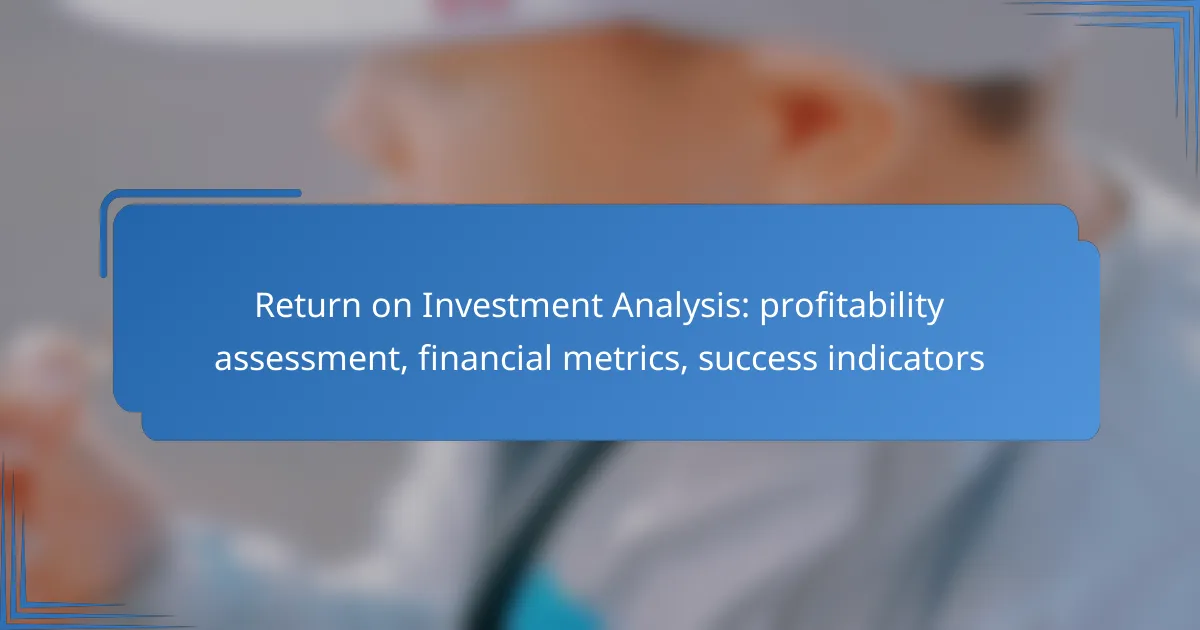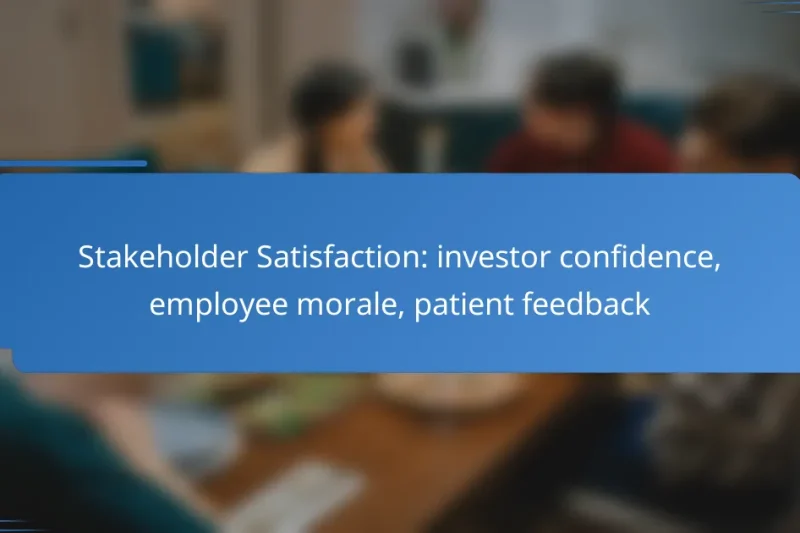Return on Investment (ROI) analysis is essential for evaluating the profitability of investments in e-commerce, allowing … Return on Investment Analysis: profitability assessment, financial metrics, success indicatorsRead more
Investment packages for healthcare facilities in Australia are designed to improve operational efficiency, enhance patient care, and promote sustainability. By focusing on facility upgrades, technology integration, and energy efficiency, these packages provide essential resources that lead to better patient outcomes and streamlined operations. Careful consideration of budget, facility needs, and regulatory compliance is vital for maximizing the effectiveness of these investments.
Stakeholder Satisfaction: investor confidence, employee morale, patient feedback
Stakeholder satisfaction is crucial for the success of any organization, encompassing investor confidence, employee morale, and … Stakeholder Satisfaction: investor confidence, employee morale, patient feedbackRead more
Insurance Considerations: coverage options, risk assessment, financial protection
Understanding insurance considerations is essential for securing financial protection against unforeseen events. In Australia, various coverage … Insurance Considerations: coverage options, risk assessment, financial protectionRead more
Regulatory Compliance Costs: legal fees, adherence expenses, risk management
Regulatory compliance costs in Australia represent a significant financial burden for businesses, encompassing legal fees, adherence … Regulatory Compliance Costs: legal fees, adherence expenses, risk managementRead more
Market Pricing Trends: competitive analysis, pricing strategies, market positioning
Understanding current market pricing trends is essential for businesses aiming to navigate the complexities of consumer … Market Pricing Trends: competitive analysis, pricing strategies, market positioningRead more
Facility Growth and Expansion: increased capacity, service offerings, market share
Facility growth and expansion are crucial for businesses aiming to increase capacity and enhance their market … Facility Growth and Expansion: increased capacity, service offerings, market shareRead more
Financial Risk Assessment: identifying risks, mitigation strategies, informed investments
Financial risk assessment is essential for identifying potential vulnerabilities that can impact an organization’s financial health. … Financial Risk Assessment: identifying risks, mitigation strategies, informed investmentsRead more
Sustainability Outcomes: environmental impact, eco-friendly practices, community support
In Australia, businesses can significantly improve sustainability outcomes by adopting eco-friendly practices that minimize environmental impact … Sustainability Outcomes: environmental impact, eco-friendly practices, community supportRead more
Long-term Financial Planning: future projections, sustainability, growth strategies
Long-term financial planning is essential for achieving sustainable growth and effectively managing risks in an ever-changing … Long-term Financial Planning: future projections, sustainability, growth strategiesRead more
Comprehensive Risk Management: thorough assessments, proactive strategies, minimized losses
Comprehensive risk management involves thorough assessments and proactive strategies designed to minimize potential losses for businesses. … Comprehensive Risk Management: thorough assessments, proactive strategies, minimized lossesRead more
What are the best investment packages for healthcare facilities in Australia?
The best investment packages for healthcare facilities in Australia focus on enhancing operational efficiency, patient care, and sustainability. Key areas include comprehensive facility upgrades, technology integration, energy efficiency solutions, and telehealth infrastructure investments.
Comprehensive facility upgrades
Comprehensive facility upgrades involve renovating existing spaces to improve functionality and patient experience. This can include expanding waiting areas, updating patient rooms, and enhancing accessibility features.
When planning upgrades, consider the specific needs of your facility and the community it serves. Engaging with stakeholders can help identify priorities and ensure that the renovations align with patient care goals.
Technology integration packages
Technology integration packages focus on incorporating advanced medical equipment and software systems to streamline operations. This can include electronic health records (EHR), telemedicine platforms, and diagnostic imaging technologies.
Investing in technology should be guided by the facility's current capabilities and future needs. Look for solutions that offer scalability and interoperability to maximize the return on investment.
Energy efficiency solutions
Energy efficiency solutions aim to reduce operational costs and environmental impact through improved energy management. This can involve upgrading HVAC systems, installing energy-efficient lighting, and utilizing renewable energy sources.
Facilities can benefit from government incentives and rebates for energy-efficient upgrades. Conducting an energy audit can help identify the most effective solutions tailored to your facility's usage patterns.
Telehealth infrastructure investments
Telehealth infrastructure investments are essential for expanding access to care, especially in remote areas. This includes setting up secure video conferencing systems and ensuring robust internet connectivity.
When implementing telehealth solutions, prioritize user-friendly platforms that comply with Australian privacy regulations. Training staff and educating patients on using these technologies can enhance adoption and effectiveness.
How do investment packages improve healthcare services?
Investment packages enhance healthcare services by providing the necessary funding and resources to upgrade facilities, technology, and staff training. This leads to better patient outcomes, streamlined operations, and increased capacity to serve more patients effectively.
Enhanced patient care quality
Investment packages often focus on modernizing medical equipment and adopting advanced technologies, which directly improves patient care quality. For instance, facilities can implement electronic health records (EHR) systems that streamline patient information access, leading to faster and more accurate diagnoses.
Additionally, training programs funded by these packages can enhance staff skills, ensuring that healthcare professionals are up-to-date with the latest practices. This results in more effective treatments and higher patient satisfaction levels.
Operational cost reduction
By investing in energy-efficient systems and automated processes, healthcare facilities can significantly reduce operational costs. For example, upgrading to LED lighting and energy-efficient HVAC systems can lower utility bills by a substantial percentage.
Moreover, investment in technology can minimize administrative burdens, allowing staff to focus on patient care rather than paperwork. This efficiency can lead to lower staffing costs and improved resource allocation.
Increased facility capacity
Investment packages can enable healthcare facilities to expand their physical space or enhance existing infrastructure, allowing them to accommodate more patients. This might involve constructing new wings or renovating current areas to optimize patient flow.
Additionally, with improved technology and processes, facilities can handle a higher patient volume without compromising care quality. This is particularly crucial in regions experiencing population growth or increased healthcare demand.
What factors should be considered when choosing an investment package?
When selecting an investment package for healthcare facilities, it is crucial to evaluate budget constraints, facility size and needs, and regulatory compliance. These factors will significantly influence the effectiveness and sustainability of the investment.
Budget constraints
Budget constraints are often the primary consideration when choosing an investment package. Healthcare facilities must assess their financial capacity, including available funding sources and potential return on investment (ROI). It is advisable to create a detailed budget that outlines both initial costs and ongoing expenses.
Consider exploring various financing options, such as loans, grants, or partnerships, to maximize available resources. Additionally, prioritize investments that offer the best value for money, focusing on essential upgrades that will enhance patient care and operational efficiency.
Facility size and needs
The size and specific needs of a healthcare facility play a vital role in determining the appropriate investment package. Larger facilities may require comprehensive solutions, while smaller ones might benefit from targeted improvements. Conducting a thorough needs assessment can help identify the most pressing areas for investment.
For example, a small clinic may prioritize telehealth technology to expand access, while a large hospital might focus on upgrading imaging equipment or expanding surgical suites. Tailoring the investment to the facility's unique requirements ensures that resources are allocated effectively.
Regulatory compliance
Regulatory compliance is a critical factor in selecting an investment package for healthcare facilities. Facilities must adhere to local and national regulations, including health and safety standards, data protection laws, and accreditation requirements. Non-compliance can lead to significant penalties and impact patient care.
It is essential to stay informed about relevant regulations and ensure that any investment aligns with these standards. Consulting with legal and compliance experts can provide valuable insights and help mitigate risks associated with regulatory issues.
Which companies offer investment packages for healthcare facilities?
Several companies provide tailored investment packages for healthcare facilities, focusing on enhancing infrastructure and technology. These packages often include financing options, equipment leasing, and comprehensive service agreements to meet the specific needs of healthcare providers.
Health Infrastructure Australia
Health Infrastructure Australia specializes in developing and financing major health projects across the country. They offer investment packages that cover planning, design, and construction of healthcare facilities, ensuring compliance with local regulations and standards.
When considering their packages, healthcare facilities should evaluate the total investment required, which can range from millions to hundreds of millions of AUD depending on the project's scale. It's crucial to assess the long-term operational costs and potential funding sources.
Medtronic Healthcare Solutions
Medtronic Healthcare Solutions provides investment packages that focus on medical technology and equipment financing. Their offerings often include leasing options for advanced medical devices, which can significantly reduce upfront costs for healthcare facilities.
Facilities should consider the total cost of ownership when evaluating Medtronic's packages, as leasing can lead to lower initial expenses but may involve higher long-term costs. It's advisable to analyze the specific needs for equipment and the expected return on investment.
Siemens Healthineers
Siemens Healthineers offers comprehensive investment packages that integrate medical technology with financing solutions. Their packages typically include options for purchasing or leasing diagnostic and imaging equipment, tailored to the needs of healthcare providers.
Healthcare facilities should take into account the technological advancements included in Siemens' packages, as these can enhance operational efficiency and patient care. Evaluating the financing terms and potential upgrades is essential for making an informed decision.
What are the financing options for healthcare facility investments?
Healthcare facilities can explore various financing options to support their investments, including government grants, private financing, and partnerships with investors. Each option has distinct advantages and considerations that can impact the overall funding strategy.
Government grants and subsidies
Government grants and subsidies provide financial assistance to healthcare facilities, often requiring no repayment. These funds can be used for specific projects, such as facility upgrades or technology implementation, and are typically awarded based on eligibility criteria and application processes.
Facilities should research available grants at federal, state, and local levels, as well as specific programs targeting healthcare improvements. For example, the U.S. Department of Health and Human Services offers various funding opportunities that can significantly reduce out-of-pocket expenses.
Private financing options
Private financing options include loans, lines of credit, and leasing arrangements from banks or private lenders. These options can provide quick access to capital but often come with interest rates and repayment terms that need careful consideration.
When exploring private financing, facilities should compare offers from multiple lenders and assess the total cost of borrowing. It’s advisable to maintain a strong credit profile to secure favorable terms, and consider fixed versus variable interest rates based on financial forecasts.
Partnerships with healthcare investors
Partnerships with healthcare investors can offer a strategic way to fund facility investments while sharing risks and rewards. Investors may provide capital in exchange for equity stakes or revenue-sharing agreements, which can alleviate the financial burden on the facility.
Facilities should seek investors who align with their mission and values, as well as those who bring additional expertise or resources. Clear agreements outlining roles, responsibilities, and financial expectations are crucial to ensure a successful partnership.














